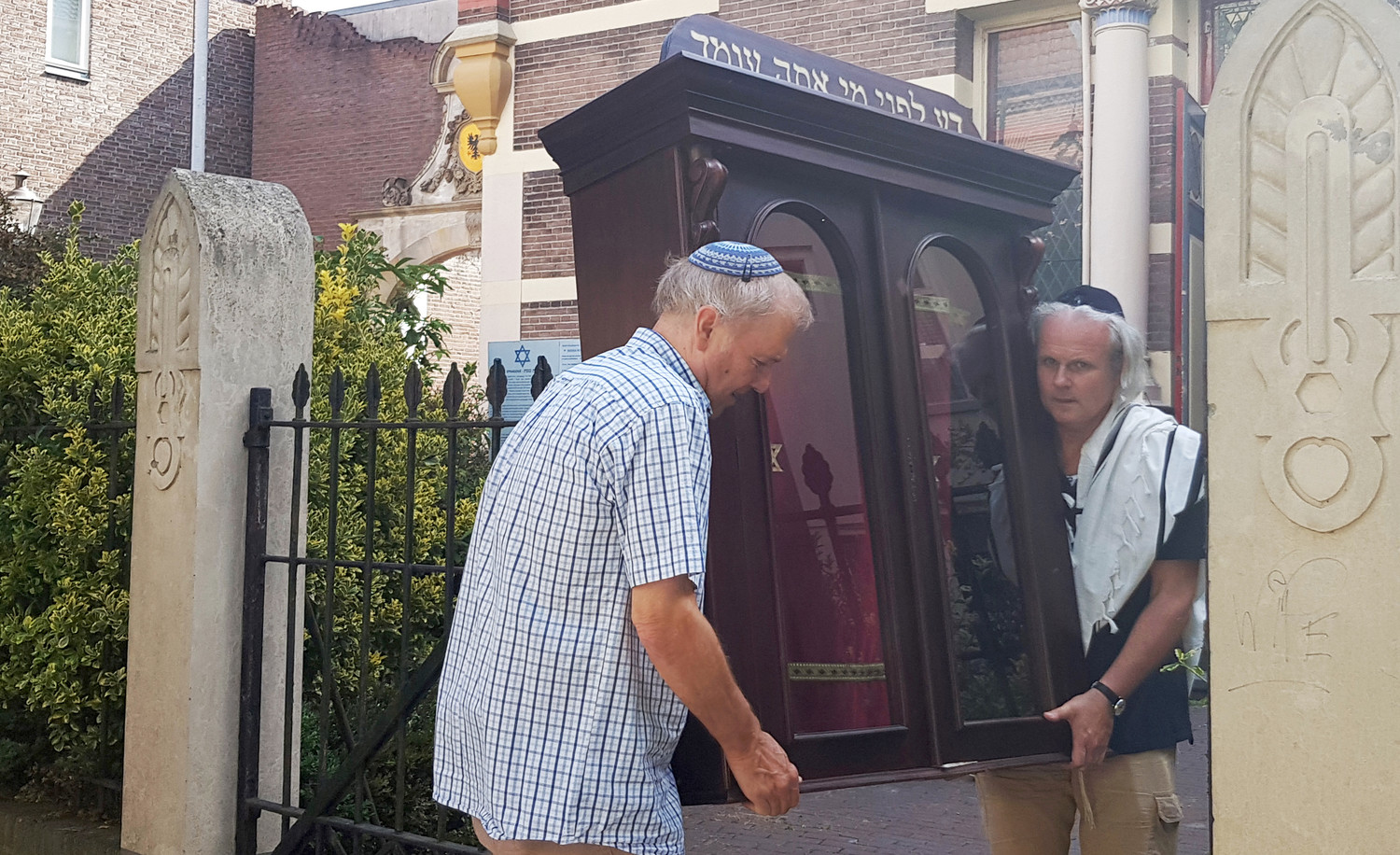Eviction of Dutch shul returns bitter memories
DEVENTER, Netherlands — Four years ago, Tom Furstenberg proudly carried into his synagogue its first Torah scroll since the Holocaust.
It was an important moment for the Beth Shoshana Masorti community established in 2010, in a city of nearly 100,000 residents 60 miles east of Amsterdam. It was proof that Jewish life had finally returned to a place from which it had been uprooted.
“I felt that this was it, nothing could reverse our presence as part of this city,” Furstenberg, a 49-year-old teacher and chairman of Deventer’s Jewish community, told JTA.
He had been overly optimistic.
On Monday, he and a dozen other members of their congregation of 35 had to take away the scroll and all the other ritual possessions and load them into a white van.
The Deventer synagogue was sold in January by the church that had owned it for decades. The developers, a Dutch-Turkish restaurant owner, evicted the congregants amid a legal fight over a plan to turn the place into an eatery.
For Deventer, the eviction meant “the end of a Jewish presence in this city,” Sanne Terlouw, a founding member of Beth Shoshana, told JTA with tears in her eyes.
But for many other Dutch Jews, the demise of the Great Synagogue of Deventer signals a broader demographic shift: Jewish life and heritage are becoming increasingly difficult to maintain outside Amsterdam, where most Dutch Jews live, because of secularization and the echoing losses of the Holocaust.
“Of course it’s sad, we’re losing a piece of our history,” said Esther Voet, editor in chief of the NIW Jewish weekly in Amsterdam. “But the reality is that this small Jewish community cannot afford to stay in that huge synagogue. That’s just the way it is.”
With no synagogue of its own, Beth Shoshana will move to nearby Raalte, where it will share space with an existing congregation. Voet says she finds this “a reasonable solution” born out of a “regrettable reality.”
But in Deventer and beyond, the evicted congregants appeared less resigned. On Monday, the congregation gathered one last time in the building they had just emptied. Sipping black coffee and eating prune cake, they sang “Am Yisrael Chai” and “Kol Ha’Olam Kulo.” Some cried; others tried to console them.
‘This was our home for a long period,” Ehud Posthumos, 79, a retired Royal Netherlands Air Force officer, told JTA. “On winter nights, we’d gather here in the cold — we never heated the place properly to save on utilities — and although outside it turned very dark early in the afternoon, here inside we had a great source of light. And now it feels like losing a home.”
Maurice Swirc, the former editor-in-chief of NIW, called the synagogue’s sale “a scandal” and found it “very painful.” Dutch authorities, he said, “were partially responsible for the fact that Deventer does not have enough Jews to maintain she synagogue. The least they could do is help preserve it.”
The affair prompted intense interest internationally. JTA’s video report of the community leaving the shul has been viewed more than 200,000 times.
Ronny Naftaniel, a founder of The Hague Jewish Heritage group, said the synagogue’s sale is unusual “for a city such as Deventer, where authorities have a high awareness for heritage.” Deventer, where Jewish cattle dealers left an indelible mark and where Naftaniel’s family lived before the Holocaust, “could have set aside this space,” he said.
Until recently, Furstenberg’s community held onto its synagogue thanks to the Christian Reformed Churches group, which bought the building in 1951 from the severely depleted Jewish community and turned it into a church, complete with a pipe organ.
In 2010, Furstenberg and other local Jews asked the church’s permission to reestablish a synagogue in the hall, which they began renting at a subsidized rate. But the church sold the building this year. The highest bidder was Ayhan Sahin, the Dutch-Turkish developer, and his associate, Carlus Lenferink.
This summer, the entrepreneurs announced their plan to turn the synagogue into a restaurant. Furstenberg objected and the city declined to approve the plan.
Amid negotiations, Sahin was quoted said, “If need be, I’ll turn it into a mosque,” according to De Stentor regional daily. He later said he would allow the community to stay if it paid full rent, an unlikely prospect for the small congregation, which could barely afford maintenance fees.
Maarten-Jan Stuurman, a spokesman for the Deventer municipality, told De Stentor that the city tried to help the community, but ultimately “it is not the city’s task to buy religious properties it does not use.” The issue of rent, he said, “is at the discretion of the owner.”
Losing the synagogue is “a major step back for the city,” Furstenberg said, his voice echoing in the empty space. “Once again, the city is looking on as its synagogue is being destroyed.”
Furstenberg’s j’accuse was a reference to the building’s wartime history. Unlike most Dutch synagogues, Deventer’s was not methodically confiscated. Instead, it was ransacked by Dutch Nazi mob on July 25, 1941. Under the watch of local police, they smashed furniture, hacked open the ark, tore up the scroll, pulled down the chandeliers and dislodged the bimah, which was built in 1892.
Of the 590 registered Jews in Deventer, the Nazis murdered 401 — typical for a country where Nazis and local collaborators killed at least 75 percent of Jews, the highest death rate in Western Europe.
Dutch Jewry, which numbered 140,000 before the Holocaust, never replenished its numbers. Today, Holland has about 45,000 Jews.
Referring to the genocide, Furstenberg said “This is the reason there are not enough Jews to afford this place.”
In the interior of the Great Synagogue, a tall building in the neo-Moorish style, he added: “This is not just a story about a dwindling faith community, like all those churches that get turned into a discotheques. This is an aftereffect of the Holocaust.”

 54.0°,
Mostly Cloudy
54.0°,
Mostly Cloudy 




